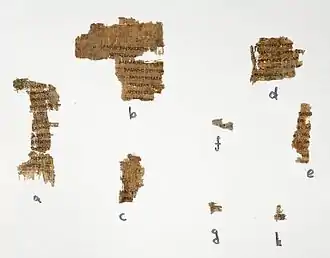Papyrus Rylands 458
Papyrus Rylands 458 (TM 62298; LDAB 3459) is a copy of the Pentateuch in a Greek version of the Hebrew Bible known as the Septuagint. It is a papyrus manuscript in roll form. The manuscript has been assigned palaeographically toward the middle of the 2nd century BC,[1] and before the discovery of the Dead Sea Scrolls it was the oldest known manuscript of the Greek Bible. The manuscript has survived in a very fragmentary condition.

Description
The text was written on papyrus in uncial letters. It is designated by the number 957 on the list of Septuagint manuscripts according to the numbering system devised by Alfred Rahlfs. The surviving texts of the Book of Deuteronomy are Deut 23:24(26)–24:3; 25:1–3; 26:12; 26:17–19; 28:31–33; 27:15; 28:2.[2]
The manuscript consists of only 8 small fragments, designated by the letters "a"–"h". Fragment "h" is the smallest and contains only two letters. The words are not divided by spaces, but written continuously. The writer uses the colorimetric system, regularly leaving a space at the end of sentence or clause.[2]
The text of the manuscript agrees more with Washington Manuscript I (WI) or Codex Alexandrinus than with Codex Vaticanus.[3]
Tetragrammaton
Martin Rösel wrote that the fragmentary manuscript contains neither Κύριος nor the Tetragrammaton, but it has "a gap in Deut. 26.18 where one would expect either κύριος or the tetragrammaton. This gap is large enough to accommodate both words, and it seems likely that the scribe of the Greek text left the space free for someone else to insert the Hebrew characters of the tetragrammaton."[4] In his view, "from the very beginnings of the translation of the Pentateuch, the translators were using κύριος as an/the equivalent for the Hebrew name of God".[5]
Anthony Meyer rejects Rösel's supposition that the Tetragrammaton was likely intended to be inserted into Rylands 458. He cites the directly opposite supposition of C. H. Roberts, who in 1936 wrote: "It is probable that κυριος was written in full, i.e. that the scribe did not employ the theological contractions almost universal in later MSS." However, Paul E. Kahle said in 1957 that Roberts had by then changed his mind and had accepted Kahle's view that "this space actually contained the Tetragrammaton". Meyer objects: There is no measurable gap, waiting to be filled. Instead, the fragment simply breaks off at this point, and Rylands 458 offers no support for the idea that it used the Tetragrammaton at this point.[6]
Albert Pietersma also says that the evidence from this manuscript has been overemphasized, "not because it is relevant to our discussion, but because it has been forcibly introduced into the discussion, in part, one surmises, because it is the oldest extant LXX MSS".[7]:91 He adds with some irony, "One hopes that this text will henceforth be banned from further discussion regarding the tetragram, since it has nothing to say about it".[7]:92
History of the scroll
Palaeographically the manuscript has been assigned to the mid-2nd century BC. It is the oldest known manuscript of the Septuagint. It is believed it came from Fayyum, where there were two Jewish synagogues.[2]
The manuscript was discovered in 1917 by J. Rendel Harris. It was examined by A. Vaccari (1936) and A. Pietersma (1985).[2] The text was edited by C. H. Roberts in 1936.[8][9]
The manuscript is currently housed at the John Rylands Library (Gr. P. 458) in Manchester,[2] giving the manuscript its name.
See also
References
- George Howard (1971). "The oldest Greek text of Deuteronomy". Hebrew Union College Annual. Jewish Institute of Religion: Hebrew Union College Press. 42: 125–131. JSTOR 23506719.
- Würthwein Ernst (1988). Der Text des Alten Testaments, Stuttgart: Deutsche Bibelgesellschaft, p. 190.
- "Bible manuscripts", Rylands Papyri, UK: Katapi.
- Martin Rösel. Tradition and Innovation: English and German Studies on the Septuagint. SBL Press; 8 October 2018. ISBN 978-0-88414-324-6. p. 295.
- Martin Rösel, "The Reading and Translation of the Divine Name in the Masoretic Tradition and the Greek Pentateuch" in Journal for the Study of the Old Testament 2007 31: 425 DOI: 10.1177/0309089207080558
- Anthony Meyer, The Divine Name in Early Judaism: Use and Non-Use in Aramaic, Hebrew, and Greek (McMaster University 2017), p. 211
- Albert Pietersma (1984). Albert Pietersma and Claude Cox (ed.). Kyrios or Tetragram: A Renewed Quest for the Original LXX (PDF). De Septuaginta. Studies in Honour of John William Wevers on his sixty-fifth birthday. Mississauga: Benben Publications.
- Roberts, C. H. (1936) Two biblical Papyri in the John Rylands Library Manchester. Manchester 1936, p. 25.
- Opitz, H. & Schaeder, H. (2009). Zum Septuaginta-Papyrus Rylands Greek 458. Zeitschrift für die Neutestamentliche Wissenschaft und die Kunde der Älteren Kirche, 35(1), pp. 115-117. Retrieved 3 Jul. 2019, from doi:10.1515/zntw.1936.35.1.115
Further reading
- Hans-Georg Opitz, and H. H. Schaeder, Zum Septuaginta-Papyrus Rylands Greek 458, ZNW (1936)
- Frederic G. Kenyon, Our Bible & the Ancient Manuscripts (4th Ed. 1939) Pg 63 & Plate VI.
- Würthwein, Ernst (1995). The text of the Old Testament: an introduction to the Biblia Hebraica. Wm. Eerdmans. p. 188. ISBN 0802807887.